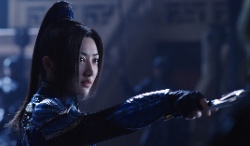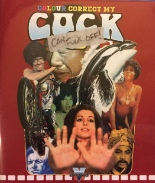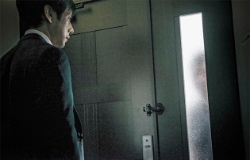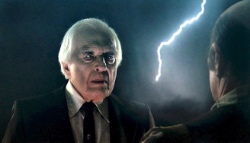
 Last October, Houston Rockets point guard Bobby Brown came under fire for signing his name and jersey number on the Great Wall of China. In the department of shame, however, Brown’s thoughtless and egotistical act of vandalism pales next to the wrongheaded disaster that is The Great Wall, an epic fantasy from House of Flying Daggers auteur Zhang Yimou.
Last October, Houston Rockets point guard Bobby Brown came under fire for signing his name and jersey number on the Great Wall of China. In the department of shame, however, Brown’s thoughtless and egotistical act of vandalism pales next to the wrongheaded disaster that is The Great Wall, an epic fantasy from House of Flying Daggers auteur Zhang Yimou.
Bearing for-the-ages bad hair, Matt Damon (Jason Bourne) and Pedro Pascal (TV’s Narcos) portray William and Tovar, a couple of non-Chinese mercenaries in China, looking to finagle some newfangled “black powder.” Being in the wrong place at the wrong time, the pair is imprisoned by the intimidating-sounding The Order and assumed to be not long for this world … until William’s ace archery skills strike The Order as a damn good defense against the Tao Tei.
 Ah, yes, the Tao Tei: those giant, reptilian creatures that try to bust through the Great Wall (hence, the title) once every six decades. Victorious or not, at least the monsters exhibit impeccable attendance. Damon’s vaguely Irish bow-and-arrow beefcake joins an acrobatic female commander (the ever-flipping Jing Tian, Police Story: Lockdown) and other bugaboo crushers on the kind of multicultural crew that fronts so many of today’s global-minded blockbusters, from Rogue One: A Star Wars Story and the Magnificent Seven remake to each successive sequel in The Fast and the Furious franchise.
Ah, yes, the Tao Tei: those giant, reptilian creatures that try to bust through the Great Wall (hence, the title) once every six decades. Victorious or not, at least the monsters exhibit impeccable attendance. Damon’s vaguely Irish bow-and-arrow beefcake joins an acrobatic female commander (the ever-flipping Jing Tian, Police Story: Lockdown) and other bugaboo crushers on the kind of multicultural crew that fronts so many of today’s global-minded blockbusters, from Rogue One: A Star Wars Story and the Magnificent Seven remake to each successive sequel in The Fast and the Furious franchise.
In all but the computer-generated threat, The Great Wall looks, well, great. But as in real life, looks aren’t everything, and indeed, this cruel mistress bores. In their color-coded armor, our heroes resemble comic-book warriors who have burst from page to screen, but Yimou has stuck them into a rote screenplay that reminded me of Reign of Fire — not a positive comparison, considering that 2002 dragon-festooned film is one of the few times I’ve exited the theater mid-movie.
Closer to Yimou’s home turf, it also brought to mind the high-flying fantasies of Tsui Hark, who rose to world-cinema fame on the strength of mystical martial-arts adventures like 1983’s Zu: Warriors from the Magic Mountain … and then missed as often as he hit. Although Yimou’s filmography is roughly half the size of Hark’s, a more definitive through line exists in Yimou’s work; whether Raise the Red Lantern, Curse of the Golden Flower or Jet Li’s Hero, he tends to stick within his comfort zone of costumed epics, more or less grounded in realism. The Great Wall retains the man’s hallmarks — an air of elegance, fluidity of movement, a love of the historical, elaborate robing as vital as weaponry — yet in poking a hole through the arthouse to get a glimpse of the more commercial fare playing next door, his hold on mastery falls to the floor. —Rod Lott



 Those “kings of Canadian grind house trash” are at it again in
Those “kings of Canadian grind house trash” are at it again in  But mostly, as with the original Colour Correct collection, movie trailers are the menu item du jour. Whether consciously or not, sequels are well-represented, with
But mostly, as with the original Colour Correct collection, movie trailers are the menu item du jour. Whether consciously or not, sequels are well-represented, with 




